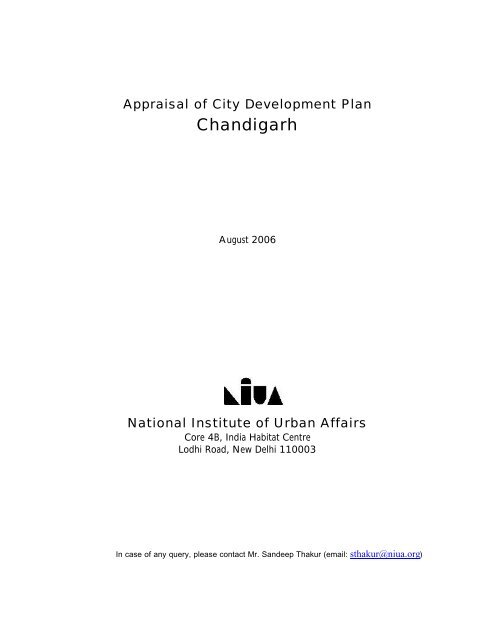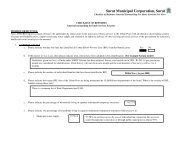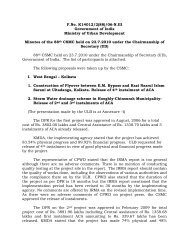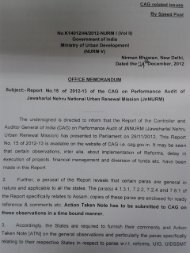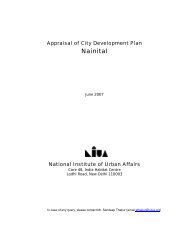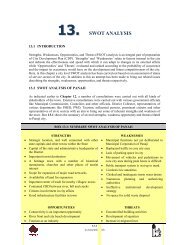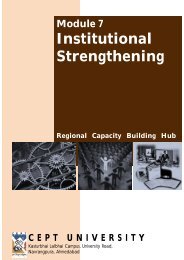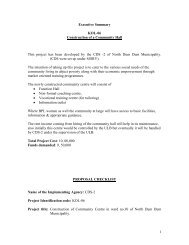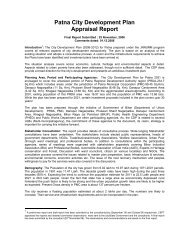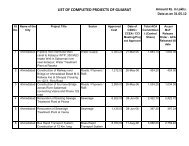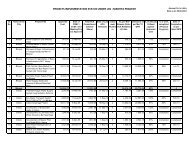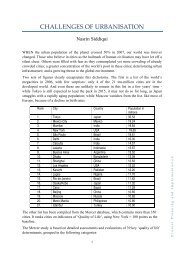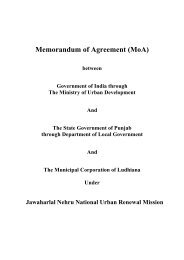Appraisal of City Development Plan: Raipur - JnNURM
Appraisal of City Development Plan: Raipur - JnNURM
Appraisal of City Development Plan: Raipur - JnNURM
Create successful ePaper yourself
Turn your PDF publications into a flip-book with our unique Google optimized e-Paper software.
<strong>Appraisal</strong> <strong>of</strong> <strong>City</strong> <strong>Development</strong> <strong>Plan</strong>ChandigarhAugust 2006National Institute <strong>of</strong> Urban AffairsCore 4B, India Habitat CentreLodhi Road, New Delhi 110003In case <strong>of</strong> any query, please contact Mr. Sandeep Thakur (email: sthakur@niua.org)
<strong>Appraisal</strong> <strong>of</strong> <strong>City</strong> <strong>Development</strong> <strong>Plan</strong>: ChandigarhThe <strong>City</strong> <strong>Development</strong> <strong>Plan</strong> (CDP) for Chandigarh has been submitted by the Finance Secretary,Chandigarh Administration. It gives a fair idea about the city on issues like city assessment andanalysis, future perspective and vision, and city investment plan. However there are some seriousproblems related to the structure <strong>of</strong> the CDP and its contents.The CDP appraisal has been divided into five sections – structure <strong>of</strong> the CDP, the city assessment,future perspective and vision, strategies for development and city investment plan.1. Structure <strong>of</strong> the <strong>City</strong> <strong>Development</strong> <strong>Plan</strong>Toolkit 2 (Formulation <strong>of</strong> the <strong>City</strong> <strong>Development</strong> <strong>Plan</strong>) <strong>of</strong> JNNURM has been designed to assist citygovernments to prepare the CDPs. This toolkit outlines the scope <strong>of</strong> CDPs and indicates therequirement <strong>of</strong> data, and suggests a methodology for analysis, together with steps to realisticallyassess the problems and to determine a medium and long-term vision for development. The structure<strong>of</strong> the CDP is not as per the guidelines provided in the toolkit. For example the first chapter <strong>of</strong> theCDP is “Abstracts <strong>of</strong> Projects”, Chapter two as “Projected Population Growth <strong>of</strong> <strong>City</strong> Chandigarh”,Chapter three is “Vision Regarding Basic Services Water Supply, Sewerage, Storm water drainageand Internal Roads”, Chapter four is “Augmentation <strong>of</strong> Existing Water Infrastructure”, Chapter five is“Investment required for Sewerage Sector,” and so on.Whereas the preparation <strong>of</strong> a CDP is a multi-stage exercise which involves (i) In-depth analysis <strong>of</strong> theexisting situation, covering the demographic, economic, financial, infrastructure, physical andenvironment and institutional aspect, (ii) <strong>Development</strong> <strong>of</strong> a perspective and a vision <strong>of</strong> the city, (iii)Formulation <strong>of</strong> a strategy for bridging the gap between where the city is and where it wishes to go and(iv) Preparing a <strong>City</strong> Investment <strong>Plan</strong> and a financing strategy. The first section <strong>of</strong> the CDP is meantto identify the strengths and weaknesses in the city’s development and to provide an understanding <strong>of</strong>what impedes service delivery and management within the existing set-up and what contributes tobetter service provision. The second section <strong>of</strong> the CDP is to be designed for using the results <strong>of</strong> firststage analysis combined with consultation with key stakeholders and civil society, this section ismeant to develop a vision for future development. The third section is meant to identify the optionsand strategies and to evaluate the strategies from the perspective <strong>of</strong> their contribution to the goals andobjectives <strong>of</strong> the JNNURM. The last section on <strong>City</strong> Investment <strong>Plan</strong> is meant to provide anaggregate investment plan not merely the financial estimates and to highlight the alternative sources<strong>of</strong> financing the vision and the accompanying strategy and programmes.2. The <strong>City</strong> Assessment2.1 <strong>City</strong> DemographyThe CDP does not adequately highlight the demography, population growth rates and composition <strong>of</strong>population growth <strong>of</strong> the city. The population <strong>of</strong> Chandigarh Municipal Corporation (CMC)mentioned in the CDP for 2001 does not match with the population <strong>of</strong> CMC as per the census 2001.1
The methodology used by the CDP for projection <strong>of</strong> population is not provided at all and projectingpopulation for the next thirty-five years based on last decadal annual growth rate is not the correctmethod <strong>of</strong> estimation. The decadal growth rates are coded as annual growth rates (Table 1 on page133). Sixty seven percent <strong>of</strong> the population increase is due to migration <strong>of</strong> population but the CDPdoes not reflect the result <strong>of</strong> migration on basic services. The exercise on population projection is notsatisfactory and since the projected demand in the core sectors depends crucially on the population inthe coming years therefore population projections should have been estimated more carefully. TheCDP has not adequately analysed the existing situation with respect to the level <strong>of</strong> services in the corearea <strong>of</strong> the city. The situation in the periphery areas with respect to coverage and level <strong>of</strong> servicesalso needs to be given in detail.The CDP needs to clarify some issues, which are confusing. For example Table 6 on page 134 quotesthirty seven percent <strong>of</strong> the work force is in primary sector, which does not seem to be feasible as therequirement <strong>of</strong> any town according to Census definitions says that at least seventy five percent <strong>of</strong> theworkforce should be from non-agriculture background. Moreover the Table on “Requirement <strong>of</strong>Water” on page 17 has taken irrigation requirements also into the consideration. These need to beclarified.2.2 Institutional Arrangements:The CDP does not provide the functional domain <strong>of</strong> CMC, which would have given a clear picture <strong>of</strong>the responsibilities <strong>of</strong> the CMC. It would also have highlighted the status <strong>of</strong> incorporation <strong>of</strong> eighteenfunctions <strong>of</strong> the Twelfth Schedule <strong>of</strong> the Seventy Fourth Constitutional Amendment. It is importantto know at this stage which <strong>of</strong> the eighteen functions are being performed by CMC and which kind <strong>of</strong>other agencies are involved in performing these functions. Table 18 (page 139) “InstitutionalResponsibility” and “Abstract <strong>of</strong> Projects” (page 1) do not clearly explain the functioning <strong>of</strong> multipleagencies and their overlapping functional domains etc. Organisational structure <strong>of</strong> these multipleagencies and functioning <strong>of</strong> line departments has also not been produced in the CDP.The CDP has indicated that several basic services such as water supply, sewerage, drainage, road etc.are being provided jointly by Chandigarh Administration and CMC. However the exact functioning<strong>of</strong> these two agencies has not been clarified in the CDP. The entire water supply does not come in thefunctional domain <strong>of</strong> the CMC. The responsibility <strong>of</strong> provision <strong>of</strong> water supply comes underEngineering Department <strong>of</strong> the State Government and CMC. There seems to be a city level watersupply and sewerage board for this purpose in the CMC area (Table 10). However the finances <strong>of</strong>city-level water supply and sewerage board (Table 10, page 136), shows that there are deficits for thelast couple <strong>of</strong> years. Similarly for other services such as wastewater disposal, storm water drainage,internal roads, street lights and solid waste management etc. the exact functional responsibility <strong>of</strong> theCMC is not clear from the CDP and information provided on page 1,7 and 139 is very confusing.2.3 Physical Infrastructure: Water Supply, Drainage and Solid Waste Management etc.The CDP has not dealt adequately with the issues related to the coverage and the level <strong>of</strong> the basicservices such as water supply, storm water drainage, solid waste management etc. such as what2
percentage <strong>of</strong> population and what percentage <strong>of</strong> area is covered with these services. Existing watersupply status on page 19 has not addressed the issues, problems and bottlenecks related to this service.Moreover the Table on “Requirement <strong>of</strong> Water” on page 17 has taken irrigation requirements also intothe consideration. These need to be clarified.Similarly the CDP has not dealt adequately with the issues related to sewerage, drainage and solidwaste management. The existing situation with respect to these service sectors is not clear. The CDPshould indicate how these services are being provided. Performance indicators for these sectors needto be provided and discussed in the CDP.2.4 Urban Basic Services for Poor:No specific details and estimates are provided in this section on the coverage and level <strong>of</strong> services inthese slum areas. The financial planning for addressing the problems <strong>of</strong> slum dwellers has not beenprovided in the CDP.2.5 Finances <strong>of</strong> the Chandigarh Municipal Corporation:Traditionally, the CMC followed a cash based single entry system for maintaining its accounts andhas not yet shifted to accrual based accounting system. No analysis related to the “Finances <strong>of</strong> CMC”has been presented in the CDP, however Tables 7 to 10 provide the financial pr<strong>of</strong>ile <strong>of</strong> Chandigarh,which has further created confusion. For example Table 7 to Table 9 on page 134 has provided theinformation on financial pr<strong>of</strong>ile, however it is not clear whether this financial pr<strong>of</strong>ile is related toCMC or Chandigarh Administration. Further it has shown huge surpluses. The state transfersincluding grants have contributed more than sixty percent to the revenue income, however the details<strong>of</strong> these state transfers and grants are not provided in the CDP. The finances <strong>of</strong> city-level watersupply and sewerage board (table 10, page 136), shows that there are deficits for the last couple <strong>of</strong>years. The break-up <strong>of</strong> income and expenditure are not available. The break-up <strong>of</strong> direct recoveriesas mentioned on page 137 (Table 12) is not available; moreover who made these direct recoveries isalso not clear from these tables. A break-up <strong>of</strong> the income and expenditure <strong>of</strong> the water board shouldhave been provided in the CDP for a clear understanding <strong>of</strong> financial issues related to the watersector.In addition, the CDP should provide the tax and non-tax base <strong>of</strong> CMC. The rate structure <strong>of</strong> tax andnon-tax sources also needs to be provided in the CDP. The tariff structure <strong>of</strong> water and drainagecharges and the revision in the tariffs should have also been provided. Demand and collection ratiosfor individual taxes and charges should be provided.3. Vision and Strategies:The chapter on Vision and strategies pages 11 to 16, titled “Vision Regarding Basic Services likeWater Supply, Storm Water Drainage and Internal Roads <strong>of</strong> in the <strong>City</strong> Beautiful Chandigarh” has notbeen presented well as it fails to explain any vision <strong>of</strong> the city for these services. The failure forcoming out with any vision for the city is partly because the city assessment related to existing3
scenario <strong>of</strong> various services has not been done properly. The vision for other sectors has not beenpresented at all. The details linking the present situation to future goals should have been presentedclearly.3.1 Stakeholder Consultations:As per the Tool Kit 2 <strong>of</strong> JNNURM, it was expected to carry out stakeholders’ consultations in thepreparation <strong>of</strong> the CDP. Details on such exercises have not been provided in the CDP. It is highlydoubtful that whether these consultations were held and the views <strong>of</strong> people were taken intoconsideration before finalizing the CDP. The future vision <strong>of</strong> the city should have been developedthrough a participatory approach and stakeholder consultations.3.2 Strategies for <strong>Development</strong>:The CDP <strong>of</strong> Chandigarh has not touched the issues related to the strategies for development at all.Without having any strategies for development it would be very difficult to make the city investmentplan.3.3 Sector-wise Funding:The information provided on “Investment required” for various services on pages 57 to 58, 63 to 65,68 to 69 does not indicate the methodology behind it. It has been observed that there are manyinformation gaps. Details <strong>of</strong> the required funding and strategies behind it should have been providedin the CDP. Prioritisation <strong>of</strong> the projects or the prioritisation <strong>of</strong> the service sectors should have beensuggested in the CDP.Sector-wise Funding Requirements <strong>of</strong> Chandigarh (2006 to 2011)ChandigarhRequiredAmount in Rs.Crore% age <strong>of</strong>TotalWater Supply 162.31 64.39Sewerage 46.38 18.40Storm Water Drainage 27.00 10.71Roads 1.62 0.64Solid Waste Management 6.25 2.48Other Infrastructure 8.50 3.37Total 252.06 100.00The above table gives details <strong>of</strong> sector-wise funding requirements and shows the main focus is onwater supply, sewerage and storm water drainage and so on. However the detailed city investmentplan (CIP) with break-up <strong>of</strong> its components for augmentation <strong>of</strong> water supply, sewerage and stormwater drainage has not been given. This section does not provide adequate reasoning and backgroundfor working out <strong>of</strong> these sectoral funding, i.e., what kind <strong>of</strong> assumptions are made for estimation <strong>of</strong>financial requirements etc.4
No plan is provided for reduction <strong>of</strong> non-revenue water and on bridging the gap between cost andrecovery. The strategies for resource augmentation and impact <strong>of</strong> reform agenda at CMC level are notproduced in the CDP.3. <strong>City</strong> Investment <strong>Plan</strong>:The CDP has provided only one table to explain the Investment <strong>Plan</strong> related to various service sectors.Page 80 gives “Investment <strong>Plan</strong> <strong>of</strong> Water supply, Sewerage, Storm water Drainage, Roads, otherInfrastructure & Solid Waste Management”. Financial information together with physical andfinancial indicators etc. and methodology should have been provided in the CDP.The financial operating plan (FOP) based on income and expenditure <strong>of</strong> the CMC has not beenprovided in the CDP. Without a complete FOP, it is quite difficult to come to any conclusion.Therefore, the CDP should present the complete financial operating plan.4. Expected Improvements1. In-depth analysis <strong>of</strong> the existing situation, covering the demographic, economic, financial,infrastructure, physical, environmental and institutional aspects.2. Explanation <strong>of</strong> physical and financial inefficiencies in the provision <strong>of</strong> services at the citylevel.3. <strong>Development</strong> <strong>of</strong> a perspective and a vision for the city combined with consultation withstakeholders and civil society.4. Functional domain <strong>of</strong> the agencies involved in the provision <strong>of</strong> basic services in the cityespecially the problems related to the working <strong>of</strong> multiple agencies together such asoverlapping functional domain etc.5. Make appropriate population projections for JNNURM time period.6. Strategies for resource augmentation at CMC level to reduce the dependency on stategovernment’s grants and other transfers.7. Sector wise financial analysis for the past five years giving financial constraints for thesectors related to water supply, sanitation, sewerage and drainage, solid wastemanagement, roads, streetlight etc.8. Status <strong>of</strong> urban poor in the city with respect to housing, coverage and level <strong>of</strong> servicesetc. Financial constraints for improving level <strong>of</strong> services <strong>of</strong> the urban poor.9. Linking <strong>of</strong> goals and vision with the existing situation.10. Detailed information on agency-wise strategies and capital investment plan.11. Complete financial operating plan.12. Prioritisation <strong>of</strong> projects with adequate reasoning.Based on the initial submission <strong>of</strong> the CDP <strong>of</strong> Chandigarh, the comments above werecommunicated to the city <strong>of</strong>ficials. As is clear from the comments, the CDP required majorrevisions. The revised CDP was resubmitted to NIUA on 11 August 2006 and this version wasagain reviewed by NIUA. Our comments on the same along with the city’s response are givenbelow.5
1. The language needs to be improved upon. Several repetitions are observed in the CDP. Thechapters and their contents need to be re-arranged.CMC:The language has been improved and the repetitions have been eliminated and the contents <strong>of</strong>the chapters have been rearranged. All such amendments has been incorporated in themodified CDP.NIUA:The Report is entirely reorganised as per the requirements and contents are much more relevant.2. The maps giving an idea about the land use pattern and existing water supply network,sewerage, drainage, roads networks etc. should have been provided.CMC:The layout plans <strong>of</strong> existing water supply, sewerage, storm and road network has beenattached in the modified CDPNIUA:These issues have been suitably addressed in the revised CDP.3. Various small towns and villages under Chandigarh UT with population break-ups shouldhave been provided.CMC:All the required information has been provided in the modified CDP. The population <strong>of</strong> thevillages surrounding Union Territory is only 1/10 th <strong>of</strong> total population <strong>of</strong> ChandigarhNIUA:These issues have been suitably addressed in the revised CDP.4. The methodology used by the CDP for projection <strong>of</strong> population should have been provided.CMC:The population has been projected on the basis <strong>of</strong> percentage increase <strong>of</strong> last decade as perguidelines <strong>of</strong> manual <strong>of</strong> water supplyNIUA:The straight-line method has been used for the population projections.5. The CDP could not clearly explain the functioning <strong>of</strong> multiple agencies and the exactproblems arising because <strong>of</strong> overlapping functional domains etc. Organisational structure <strong>of</strong>6
these multiple agencies and functioning <strong>of</strong> line departments has also not been produced in theCDP. Tables on pages 42 and 47 should be extended for 18 functions <strong>of</strong> the 12 th schedule.CMC:The operational area <strong>of</strong> the different agencies <strong>of</strong> UT such as Municipal Corporation,Engineering Department UT Chandigarh Housing Board etc. has been defined and thefunctions mentioned in the 12 th schedule transferred to Corporation have been depicted in theCDP.NIUA:The status <strong>of</strong> 18 functions <strong>of</strong> the 12 th Schedule is well explained and functioning <strong>of</strong> multipleagencies is provided with adequate details.6. The CDP is more focused on water sector e.g. pages 134 to 196 has been devoted to watersector alone and less attention has been paid to other important sectors that has been coveredfrom page 198 to page 219.CMC:Almost all the sectors have been covered in the CDP such as water supply, sewerage, stormwater drainage, roads, elevated highway, transport etc. The details <strong>of</strong> the finances <strong>of</strong> theyears 2001-02 to 2004-05 have been explained in the modified CDPNIUA:Repetitions are removed and details <strong>of</strong> other sectors are also included.7. The chapter 4 on “Municipal Infrastructure” is mixed up with municipal finance issues. Thecity finances and municipal finance related issues should have been dealt separately.Moreover merely providing a few tables on municipal finances etc. does not solve the purpose<strong>of</strong> understanding the constraints related city finances.CMC:The necessary amendment has been incorporated in the modified CDP. The finances issueshave been depicted separately.NIUA:Detailed analysis on this issue has been provided in the revised CDP.8. Details <strong>of</strong> income-expenditure statement for Chandigarh Municipal Corporation andChandigarh Administration have not been provided. Table on page 72 could not beunderstood and has created confusions.CMC:The details <strong>of</strong> the income and expenditure statements <strong>of</strong> Chandigarh administration andMunicipal Corporation have now been clearly depicted in the modified CDP.7
NIUA:Detailed analysis on this issue has been provided in the revised CDP.9. Explanations and details for <strong>Plan</strong> and Non-<strong>Plan</strong> expenditures should have been provided.10. Tables on pages 72A to 108 should have been provided with clear explanations and itsfinancial analysis and interpretations.11. The CDP should provide the tax and non-tax base <strong>of</strong> CMC. The rate structure <strong>of</strong> tax and nontaxsources also needs to be provided in the CDP. Demand and collection ratios forindividual taxes and charges should be provided.CMC:The plan expenditure consists <strong>of</strong> capital expenditure and non-plan expenditure consist <strong>of</strong>revenue expenditure. The details <strong>of</strong> finances provided in the tables have been amended andincorporated in the modified CDP. The modified CDP provides the information <strong>of</strong> taxableand non-taxable income <strong>of</strong> the Municipal Corporation.NIUA: Detailed analysis on this issue has been provided in the revised CDP and a newchapter on “Finances <strong>of</strong> Chandigarh” has been included.12. The financial operating plan (FOP) based on income and expenditure <strong>of</strong> the CMC has notbeen provided and without a complete FOP, it is quite difficult to understand its futurefinancial implications. The CDP should include the complete financial operating planexplaining the base case scenario and investment scenario with appropriate assumptions.CMC:The details <strong>of</strong> the financial operative plans have been attached on the basis <strong>of</strong> income andexpenditure <strong>of</strong> the corporation and it was clarified that the corporation and it was clarifiedthat the municipals corporation , Chandigarh used to get grant from ChandigarhAdministration because the functions transferred to the M.C. were earlier controlled byChandigarh Administration . Necessary explanation has been provided in the modified CDPNIUA:Detailed analysis on this issue has been provided in the revised CDP and a new chapter on“Financial Operating <strong>Plan</strong>” has been included.13. No specific details and estimates are provided in this section on the coverage and level <strong>of</strong>services in these slum areas. The financial planning for addressing the problems <strong>of</strong> slumdwellers has not been provided in the CDP.CMC:It has been elaborated in the CDP that even the slums in the Chandigarh are provided withthe facilities <strong>of</strong> piped water supply through common stand posts and sulabh sauchalayas .Now the corporation has approved an estimate for providing 500 W.Cs. in the slum areas8
with the cost <strong>of</strong> Rs. 60 lacs to eliminate the open defecation in the city Chandigarh and tomake it free from open defecation.NIUA:Coverage details are incorporated.14. Sections on Transport Strategy <strong>Plan</strong> and Elevated Highways have missed the link with earliersections <strong>of</strong> the CDP and the purpose <strong>of</strong> providing these sections could not be understood.CMC:The financial requirement in respect <strong>of</strong> transport and elevated highway has been projected onthe basis <strong>of</strong> traffic survey as there is lot congestion on the city roads particularly in transportchowk, Sector 26 which is connected with the National highway No. 21NIUA:Explanations are provided and it has been included in the revised Table on page 121.NIUA: The CDP is now in accordance with the guidelines <strong>of</strong> the JNNURM Toolkit Number 2.9


